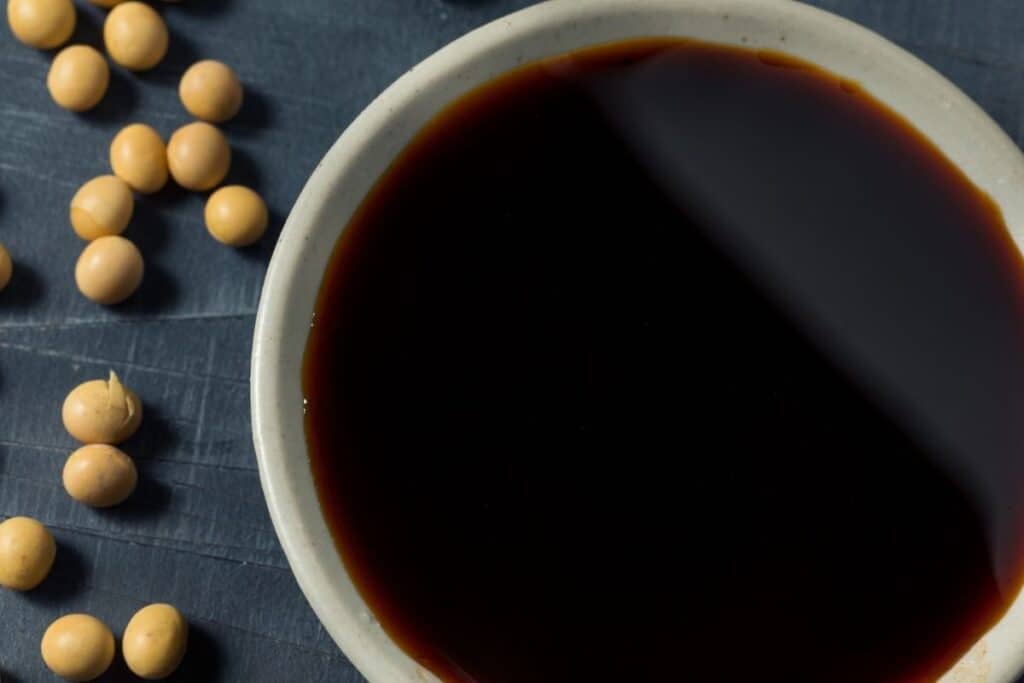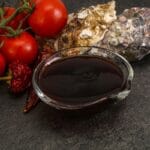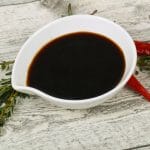In short, the best alternatives to Tamari include soy sauce, hoisin sauce, soy and hoisin combination, oyster sauce, teriyaki sauce, etc. Each substitute has its flavor profile and best uses, like marinades, stir-fries, or sauces. Consider dietary restrictions and adjust quantities as needed.
Tamari is the Japanese cousin of soy sauce, and unless you prepare a lot of Asian cuisine, you are most likely to have soy rather than tamari in your pantry. If your recipe calls for tamari sauce and you‘ve got everything but tamari in the cupboard, don’t rush to the store yet. There’s bound to be a suitable substitute right under your nose.
In this guide, we’ll dive into what tamari sauce adds to your dish and how to choose the best tamari substitutes for different types of Asian dishes.
What Is Tamari?
Tamari is a Japanese sauce, very similar to soy. In most cases, it does not include wheat or any grains in the manufacturing process, which makes it a great gluten-free alternative to soy. The sauce is derived from the juices draining off fermenting soybeans in the production of miso paste.
Besides being used as a dip for sushi, the tamari soy sauce is commonly used to add great umami depth to stir fries, marinades, soups, sauces, and dumplings, as well as tofu, noodle, and rice dishes.
Best Tamari Substitutes
Soy Sauce
The most obvious and easiest alternative is soy sauce. Since it is another fermented soybean product (used largely in Chinese cuisine), its color and flavor are very similar. It’s very versatile and can be used in pretty much any recipe that calls for tamari.
The production process is a little different since the soybeans are soaked and then cooked. They are fermented in brine with other ingredients (including wheat) and then pressed and strained. The pasteurized liquid is the dark brown and salty soy sauce.
Compared to tamari, soy has a thinner consistency and is saltier. Dark soy sauce would be the best alternative, however, Chinese style soy sauce or other soy sauces will also do the trick. If you are watching your salt intake, opt for a low-sodium version.
It can be used in everything from marinades, stir-fry, broth, and sauces to pork, seafood, poultry, and egg dishes. If you replace it in equal quantities, you will want to avoid adding salt further to the dish. If your dish is already salty from other ingredients, use a little less soy as a tamari replacement.
See more: What can I substitute for soy sauce?
Soy and Hoisin Sauce Combination
If you have regular soy sauce and hoisin in the pantry, combine the two. This will give you the slightly thicker consistency from hoisin and add great umami taste with sweet and savory notes. Mix the two sauces in equal parts to replace the exact amount of tamari required in the recipe. This is a superb option for marinades and stir fry sauce.
Hoisin Sauce
If you don’t have soy sauce, but only have hoisin, it can be used as a suitable replacement on its own. It has a sweet flavor compared to tamari but also brings a slight salty depth. Some types contain other ingredients such as garlic and red chili peppers.
If the reason you’re looking for a substitute is that you have a soy allergy, then look further down the list since hoisin is also derived from fermented soybeans. This Asian stir fry sauce won’t soak into meat as well as the thinner tamari but does form a delicious glaze on the surface.
Start by using an equal quantity and then add more to taste if needed or add an extra pinch of salt to taste. It is an especially good substitute for stir fry, marinades, and as a dipping sauce.
See more: Hoisin sauce replacement
Oyster Sauce
Don’t worry about the name, oyster sauce won’t make your dish taste fishy. Although it is made with oyster extract, the addition of other ingredients in the production process gives it a sweet-salty flavor instead. It has a deep caramel color and slightly thicker consistency which makes it ideal for dipping as well as marinades, sauces, stir-fry and to use with a variety of meat and poultry dishes. If you have fresh oysters, you can make caramelized oyster juices to use as well.
Since it does contain oyster extract, it won’t be suitable for vegans or people with shellfish or seafood allergies. If neither of these are an issue, replace it in equal quantities or use a little more oyster sauce than what is called for in the recipe. Keep in mind that it is a little sweeter which may affect your flavor profiles.
Related: What can you replace oyster sauce with?
Teriyaki Sauce
Teriyaki is another good replacement for a poultry glaze or marinade. It has a similar base flavor profile with added seasonings and sugar. It may give you a slightly sweeter taste but this usually is not a problem in stir fry, marinades, or even for dipping. Besides being used for dipping, it is generally a cooking sauce rather than a condiment.
Worcestershire Sauce
Worcestershire sauce is not a good choice for dipping or stir-fry as it has a thinner consistency and strong vinegar notes. However, this is a good substitute for tamari in stews, meat dishes, and marinades. It has a complex flavor and although it contains garlic, anchovies, onion, spices, tamarind extract, and molasses, they all blend together to form a unique flavor as opposed to being individually identifiable. As with oyster sauce, despite the addition of anchovy, there is no fishy taste here. You can substitute Worcestershire sauce in equal quantities as an alternative.
Related: What can I use instead of worcestershire sauce?
Liquid Aminos
Liquid aminos is very much like soy, except that the production process does not include fermentation of the beans. It is often used as a gluten-free soy sauce and is a great option if you’re on a gluten-free diet. However, we always advise you to check the label just to be sure. This can be used as a replacement in any dish that requires tamari in equal quantities.
Coconut Aminos
Coconut aminos is the soy-free version of liquid aminos and is made from fermented coconut tree sap. Since it is not made from the coconut water or coconut milk itself, it has no coconut flavor and therefore won’t change the flavor profile of your dish.
If you are looking for a low sodium soy sauce alternative that is gluten-free, this is your best choice. Substitute tamari in equal measures in any recipe from sauces, stews, and marinades, to stir-fries, fish, and rice dishes.
See more: Coconut aminos replacement
Miso Paste
Super salty miso is a thick fermented soybean paste. It comes in different varieties, and if you have an option, red miso is the best kind to use as a substitute. The paste shouldn’t be used as is, but instead, be diluted with water.
Mix miso well with enough water to form an even consistency similar to tamari, and then replace it in equal quantities. Make sure to taste it first since it is very easy to overpower the dish with intense saltiness. If you’re unsure, start with a smaller amount and slowly add to taste.
It may not bring the exact same flavor profile as tamari but will add saltiness and good depth of flavor to stews, marinades, and broths as long as it is well dissolved into the liquid.
Fish Sauce
Fish sauce is made from salt fermented fish such as anchovies or krill. It has a pungent aroma, however, will bring a great umami flavor to your dish. With fish sauce a little goes a long way. Start by only using a quarter of the amount required in your recipe when using it as a good tamari substitute. It is best used in conjunction with other strong flavors to enhance them, rather than as a sauce or seasoning by itself.
See more: What is a good substitute for fish sauce?
Maggi Seasoning
If you are familiar with vegemite, Maggi sauce has a similar flavor but a much thinner consistency. It won’t be suitable for wheat or gluten allergies since it is made from fermented wheat proteins. Its powerful salty taste and dark color should be added in small amounts to avoid overpowering other flavors in the dish. It’s a great addition to stews, soup, noodle dishes, stir fry, marinades, meat, and egg dishes.
Salt
If you don’t have any of the above alternatives on hand, instead of leaving the ingredient out completely, just add some salt as an alternative. It does not add the depth of flavor or sweet nuances of other sauces, but it will enhance other ingredients. This is only a suitable option when tamari is required for a little seasoning and not in cases where you need a liquid base such as in marinade or for dipping.
Balsamic Vinegar
If you’re looking for a substitute with a slightly different flavor, balsamic vinegar can be the right choice for you. Since it is vinegar, it has a flavor profile that is sour, salty, and a bit fruity. It has a thinner consistency than tamari, so it won’t be suitable as a dip but can be used successfully in dressings and marinades.
The strong flavor is toned down when cooking which also makes it ideal for stews, and meat, fish, or poultry dishes. Only use half the amount required when using it as a substitute and slowly add to taste. If you’re missing sweetness, a little honey or brown sugar can be mixed in, especially when using it as a marinade or in salad dressings.
Umeboshi Vinegar
Another vinegar you can use as an alternative is the Japanese plum vinegar, umeboshi. Like balsamic vinegar it is soy-free. This vinegar has a slight fruity tang, is salty, and is often incorporated with fish dishes. It can also be combined into stir fry or dressings. Start with only half the amount the recipe calls for as it can easily overpower other flavors in your dish.
FAQ
Conclusion
You may be looking for a tamari sauce substitute due to allergies, health conditions, not having any, or just because you’re not particularly fond of the flavor. Whatever the reason is, there are plenty of options that add the same rich umami flavor to savory dishes.
For a soy-free tamari alternative, coconut or liquid aminos are good options as well as Worcestershire, umeboshi, or balsamic vinegar. Always check the label as manufacturers may differ in their product ingredients.
If you have a fish or seafood allergy, stay clear of fish sauce, oyster sauce, and anchovies. For the closest flavor match, opt for soy sauce, diluted miso, or a soy and hoisin blend. As always, keep tasting as you cook, since salt levels can quickly add up between different ingredients and overpower your dish.
*image by bhofack2/depositphotos









